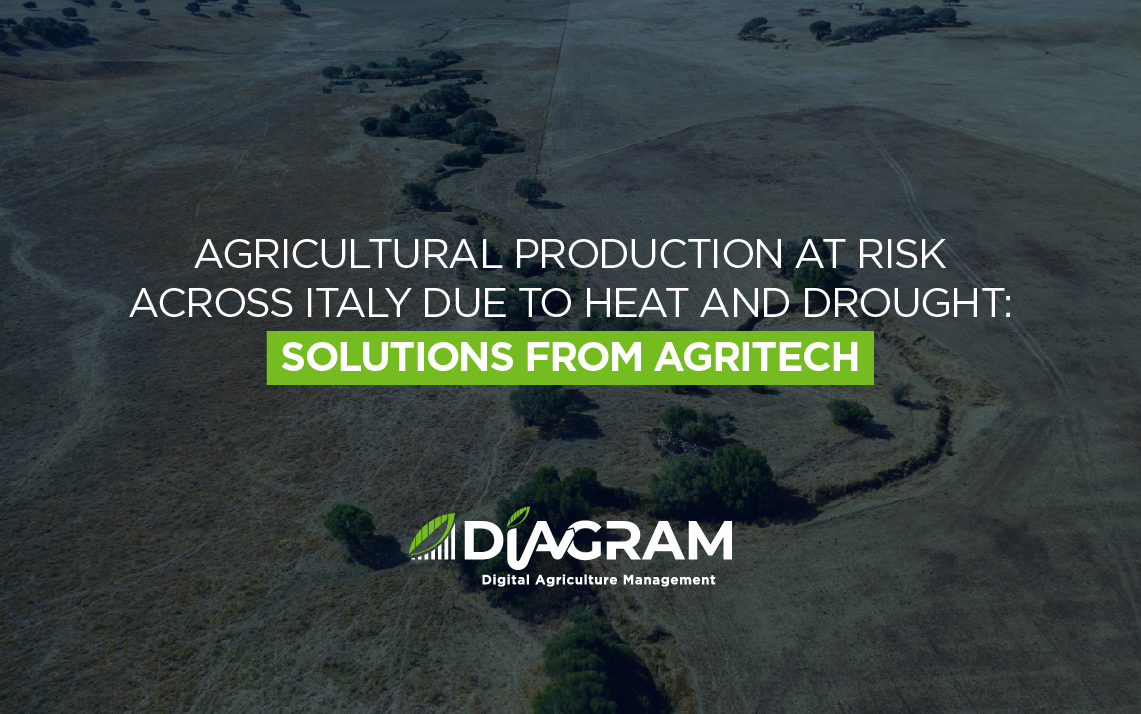
Agricultural production at risk across Italy due to heat and drought: solutions from agritech
- Roberto Mancini, CEO of Diagram Group: ‘The focus must increasingly be on innovative solutions for a resilient agricultural model. Optimal water management, as well as protecting crops from heat and sun damage, are no longer optional choices, but primary necessities. Investing in technologies such as smart irrigation is crucial to ensure the long-term sustainability of the agricultural sector.”
- Among the effects of the heat of these days is the endangering of Italian fruit and vegetable production.
Jolanda di Savoia, 8, July 2025 – Italy is hit by a heat and drought emergency that is putting the entire agricultural sector under severe strain. In particular, seasonal horticultural production is suffering severe damage, but the effects of the excessive heat are being felt throughout the agricultural chain. Distressed farmers are being forced to resort to emergency solutions, such as extraordinary irrigation and shading systems.
According to the study ‘Insurance and risk management tools for EU agriculture’, published by the European Investment Bank (EIB) and the European Commission, the European agricultural sector loses an average of EUR 28 billion per year or 6.4 per cent of EU harvests. Losses that will even exceed EUR 40 billion a year by 2050, a year in which agricultural production losses of EUR 51-57 billion are expected, which could reach EUR 90 billion if livestock farming is taken into account.
In Italy, the situation is extremely critical: in recent weeks, production losses in strategic sectors such as cereals, vegetables, fruit and fodder have already exceeded 30 per cent in several regions, with peaks of 50 per cent in some particularly affected areas. Desertification is advancing, especially in the South, threatening biodiversity and soil fertility: each non-irrigated hectare can lose up to EUR 13,500 in value, with a potential impact of over EUR 92 billion on the entire agricultural sector.
Among the crops most affected by this situation are vineyards. In Italy, in fact, about 225,000 hectares of vineyards are irrigated, equivalent to 9.5% of the total irrigated agricultural areas. The average water requirement for vines is around 4,000 m³/ha per season, and the irrigation techniques used, such as drip micro-irrigation (21.5%) and sprinkling (38%), are fundamental to guarantee quality production. Optimal water management, therefore, not only helps to preserve crop profitability, but is crucial for the economic and production sustainability of the entire agricultural sector.
The prolonged lack of rainfall, combined with record temperatures, threatens national food production and the survival of thousands of farms,’ comments Roberto Mancini, CEO of Diagram Group, the Italian and European leader in precision agriculture solutions. “In this scenario, the focus must be increasingly on innovative solutions to build resilient, agritech-based agriculture. Water management and crop protection from heat have become primary needs for farmers, who now have the opportunity to take advantage of technology,” Mancini adds. “Traditional irrigation networks are no longer sufficient to cope with the new climatic conditions, and there is an urgent need to review strategies. In this context, technological innovation is no longer a choice, but a necessity,” Mancini concludes.
Help comes from technology. Diagram Group provides precision irrigation solutions using IoT (Internet of Things) sensors placed in the soil, crop water stress analysis and predictive algorithms based on artificial intelligence, and automatic valves to open and close the irrigation flow. This enables farmers to deliver the right amount of water only when and where it is needed, reduce wastage by up to 50% and optimise the use of an increasingly scarce resource. Highly efficient drip irrigation systems, combined with these technologies, ensure targeted delivery directly to the root, minimising evaporation.
Diagram Group also provides data collection, monitoring and sensor services in line with the legal requirements for agri-voltaic systems. In a changing climate, agri-voltaics can sometimes represent an opportunity against excessive heat and certain calamities.
Among the advantages, in fact, is the reduction of water stress as partial shade reduces evaporation from the soil and plant transpiration, which significantly decreases the water requirements of crops and protects them from excessive heat waves. Furthermore, agri-voltaic structures can offer physical protection against hailstorms, strong winds and late frosts. Added to this is the fact that reducing direct exposure to the sun can help maintain a higher moisture content in the soil, favouring microfauna and improving long-term fertility.
Diagram
Diagram was born in 2024 from the transformation of the IBF Servizi SpA Group and the acquisitions of Agronica Srl, Abaco SpA, Agriconsulting SpA and Netsens Srl. It is an Italian and European leader in the digitalisation of services dedicated to the agri-food sector, in the development of farm management software and in the management of delivery processes, monitoring and control of environmental and agricultural support programmes. A partner of important governments on the European continent, it supports public administration, agricultural companies, banking and insurance institutions and the agri-food industry with the aim of promoting social, economic and environmental sustainability. Today the company is 41.6% owned by CDP Equity (Cassa Depositi e Prestiti Group), 41.6% by Trilantic Europe and 15% by BF Agricola.
